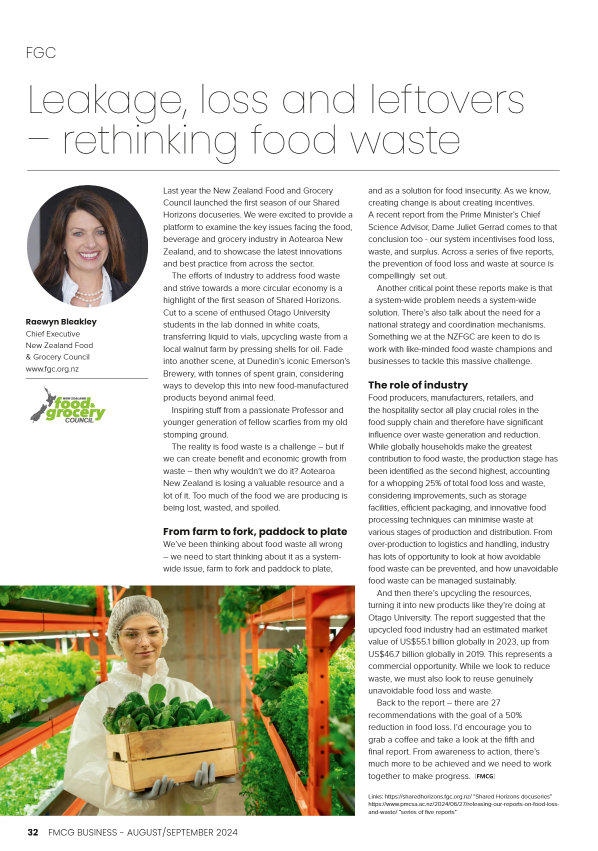FMCG Business Magazine Column: Leakage, Loss, and Leftovers – rethinking food waste
FMCG Business August-September 2024 by The Intermedia Group – Issuu
Spent Grain and Walnut Shells
Last year the New Zealand Food and Grocery Council launched the first season of our Shared Horizons docuseries. We were excited to provide a platform to examine the key issues facing the food, beverage and grocery industry in Aotearoa New Zealand, and to showcase the latest innovations and best practice from across the sector.
The efforts of industry to address food waste and strive towards a more circular economy is a highlight of the first season of Shared Horizons. Cut to a scene of enthused Otago University students in the lab donned in white coats, transferring liquid to vials, upcycling waste from a local walnut farm by pressing shells for oil. Fade into another scene, at Dunedin’s iconic Emerson’s Brewery, with tonnes of spent grain, considering ways to develop this into new food-manufactured products beyond animal feed. Inspiring stuff from a passionate Professor and younger generation of fellow scarfies from my old stomping ground.
The reality is food waste is a challenge – but if we can create benefit and economic growth from waste – then why wouldn’t we do it? Aotearoa New Zealand is losing a valuable resource and a lot of it. Too much of the food we are producing is being lost, wasted, and spoiled.
From farm to fork, paddock to plate
We’ve been thinking about food waste all wrong – we need to start thinking about it as a system-wide issue, farm to fork and paddock to plate, and as a solution for food insecurity. As we know, creating change is about creating incentives. A recent report from the Prime Minister’s Chief Science Advisor, Dame Juliet Gerrad comes to that conclusion too – our system incentivises food loss, waste, and surplus. Across a series of five reports, the prevention of food loss and waste at source is compellingly set out.
Another critical point these reports make is that a system-wide problem needs a system-wide solution. There’s also talk about the need for a national strategy and coordination mechanisms. Something we at the NZFGC are keen to do is work with like-minded food waste champions and businesses to tackle this massive challenge.
The role of industry
Food producers, manufacturers, retailers, and the hospitality sector all play crucial roles in the food supply chain and therefore have significant influence over waste generation and reduction. While globally households make the greatest contribution to food waste, the production stage has been identified as the second highest, accounting for a whopping 25% of total food loss and waste, considering improvements, such as storage facilities, efficient packaging, and innovative food processing techniques can minimise waste at various stages of production and distribution. From over-production to logistics and handling, industry has lots of opportunity to look at how avoidable food waste can be prevented, and how unavoidable food waste can be managed sustainably.
And then there’s upcycling the resources, turning it into new products like they’re doing at Otago University. The report suggested that the upcycled food industry had an estimated market value of US$55.1 billion globally in 2023, up from US$46.7 billion globally in 2019. This represents a commercial opportunity. While we look to reduce waste, we must also look to reuse genuinely unavoidable food loss and waste.
Back to the report – there are 27 recommendations with the goal of a 50% reduction in food loss. I’d encourage you to grab a coffee and take a look at the fifth and final report. From awareness to action, there’s much more to be achieved and we need to work together to make progress.
ENDS
Links:
https://sharedhorizons.fgc.org.nz/ “Shared Horizons docuseries”
https://www.pmcsa.ac.nz/2024/06/27/releasing-our-reports-on-food-loss-and-waste/ “series of five reports”

